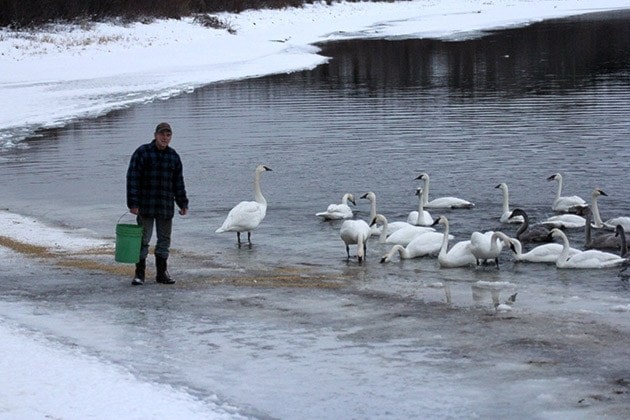This year’s early spring may have brought some of Vanderhoof’s iconic trumpeter swans to the Nechako River sooner than before, and for others, the area continues to provide a winter home, thanks to local businesses and farmers.
To feed up to 175 swans a day from November to March by their home 60 kilometres south of Vanderhoof, Denis and June Wood receive each fall 12,000 lbs of grain, donated by Vanderhoof and Districts Co-op and delivered by Yellowhead Road & Bridge of Vanderhoof, Denis explained.
“Prior to that, we collected grain — oats and barley that farmers were not able to sell for one reason or another,” he said. “It was not quite up to proper standards, but it was okay for feeding to the swans.”
The swans in the area were first fed in the early 1970s by June’s father Bert Irvine near his home, 20 kilometres upstream from the Woods.
“Overwintering trumpeter swans are attracted to the area because the open water allows them to forage for food, scarce as it is,” June said. “My dad started throwing grain onto the shore ice to help the swans out a little.”
Each spring and fall, the swans are known to stop by the Vanderhoof region during their migration, though more and more stayed by the Upper Nechako River, she said.
“At first, there was always a broken bag or two of grain at the Co-op feed store that they were happy to donate, but once several tons per year were required, it became a big commitment,” June said.
Though the grain only supplements the swans’ natural diet of water plants and roots, feeding the large number of swans became “quite a chore” for Irvine by the early 2000s, and the YRB got involved.
One winter, Irvine ran into Dave Geernaert, who was working for YRB at the time, she explained.
“Dave asked when he was going to start feeding the swans and my dad replied that he was thinking about not doing it anymore because lining up the grain, hauling it and unloading it was getting too much for him,” June said. “Dave was really taken back and immediately committed YRB to arranging for and hauling out all the grain, in a single load on a big flatbed truck.”
For Vanderhoof Co-op, it’s a worthwhile contribution for many years to support wildlife and nature, started from the time of its previous general manager Cliff Irving, said Allan Bieganski.
“Not only do we help support the local farmer by buying grain, we also help support Denis and June in their mission to feed the swans and the geese,” Bieganski said. “If Denis and June are willing to take the time all winter long to make sure they’re fed, we were honoured to help them do that.
“We take enough away from nature, so it helps us make sure we put back in,”
For YRB’s operations and quality manager Mike Svensen, it’s a community effort.
“It’s not just one fellow who donates, but many of them,” Svensen said. “It’s something that needs to be done.
“They would like to continue to feed the swans and they need the feed, so we continue to deliver it, donating the equipment and the time.”
Then and now
With this year’s early spring, June saw the trumpeter swans leaving the Vanderhoof area earlier as well, June said.
“But there’s always next year, and they always come back,” she said. “Sometime in October, there’ll be a few swans on the little lakes out here, and next thing we know, they’re flying over the house.
“They know exactly when to come.”
The swans are fed twice a day — at 8 a.m. and 3 p.m — during winter, becoming more accustomed to the Woods as the season goes on; “you can walk among them,” June explained.
“They are a little shy when they first get here, nervous,” she said. “[Denis] has some of the younger ones that he can feed right out of his hands.
“Sometimes Denis is late feeding and some of them fly low over the yard. They crane their necks and look down, as if saying, ‘What’s going on, come on, why are you late.’”
While the swans are still in Vanderhoof, June invites the community to visit and see the district’s iconic bird. “Both of us can’t leave here at the same time in the winter because of the swans,” she said. “We are dedicated to them.”
